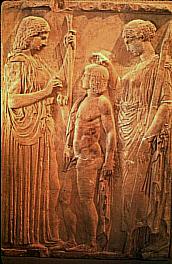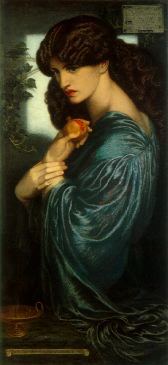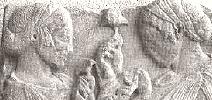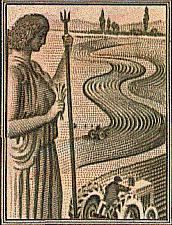DHMHTHR
(Demeter)
Goddess of the Harvest
|
Roman Name: Ceres |
The background image in the table above may look like rice, but actually it's grains of wheat. Honest!
Images of Demeter are available courtesy of Laurel Bowman's Classical Myth: The Ancient Sources
As Aphrodite was the goddess of animal fertility, Demeter was the goddess of vegetable fertility. Thus, her Roman name, Ceres, is the root of the English word "cereal," which referred to grains in general before the age of Kellogg's Corn Flakes.
 And speaking of
corn, when Demeter is referred to as "the goddess of corn" this is not a
reference to maize (the vegetable that Americans call "corn"), but rather to wheat.
That's because the early mythographers in the English language were British, and in
Britain the term refers to cereal (in the pre-Kelloggian sense) grain.
And speaking of
corn, when Demeter is referred to as "the goddess of corn" this is not a
reference to maize (the vegetable that Americans call "corn"), but rather to wheat.
That's because the early mythographers in the English language were British, and in
Britain the term refers to cereal (in the pre-Kelloggian sense) grain.
 In ancient
depictions of her you will almost always see her carrying a sheaf of wheat, and never
an ear of corn. If you'll think back to your days in grade school, you'll remember
that maize is a New World crop that the Indians introduced to the Pilgrims.
In ancient
depictions of her you will almost always see her carrying a sheaf of wheat, and never
an ear of corn. If you'll think back to your days in grade school, you'll remember
that maize is a New World crop that the Indians introduced to the Pilgrims.
Okay, now we've got that cleared up, let's look at Demeter's history.
Unlike the contradictory stories about Aphrodite, whom some authors claim as the oldest of the goddesses and others claim as the daughter of Zeus and either Dione or Metis (yes, Metis--Athena's mom), Demeter's biography is straightforward. She is one of the senior generation of the Olympian pantheon, along with her sisters Hera and Hestia and her brothers Zeus, Poseidon, and Hades. They are all the children of the ill-fated Cronus and the earth goddess Rhea.
You'll notice that the Cronus link ends with an interesting indication that it is Cronus who is associated with the harvest aspect, as opposed to the fertility aspect. Rhea produces; Cronus reaps:
In Athens on the 12th day of the month Hekatombaion a festival was held in honour of Cronus, which was known as the "Kronia." It was a celebration of the harvest. In art, Cronus was depicted carrying a sickle used to gather the harvest, but this was also the weapon he used to castrate his father.If you're wondering whether it's about time for the "Kronia," I'm sorry to report it's too late. I checked a site on the Athenian calendar and it seems that Hekatombaion started in early July. Our climate's a bit different from theirs, you know!
I only included the Rhea link because I think the part about the lion chariot is pretty cool.

Demeter combines elements of both her parents, as she is the goddess of fertility and harvest all in one. Her first worshipper was Triptolemus, a native of Eleusis to whom Demeter gave the secret of cultivating grain, along with a magic chariot so he could travel around and spread the news, sowing crops as he went. Think of him as a mythological precursor to our American folk hero Johnny Appleseed.
The photograph shown here is of an ancient relief that was found at Eleusis, representing Demeter and her daughter Persephonê (Roman name Proserpina) presenting Triptolemus with his first set of seeds. The image in the top right-hand corner of this page is taken from a Greek postage stamp; if you scroll up and take another look at it, you'll see that it is clearly based on the Eleusis relief, only Triptolemus's chariot appears to have metamorphosed into a tractor.
 Persephonê and Eleusis are Demeter's two most famous associations. The "Rape of Persephonê" is described in such gorgeous detail in the Homeric Hymn to Demeter, which
Powell has included almost in its entirety, that I
hardly need to go into any detail about it here. But I would like to
mention that this is another one of those tricky words that have changed meaning; "rape"
here means "abduction," though obviously the modern meaning underlies it in this case.
Persephonê and Eleusis are Demeter's two most famous associations. The "Rape of Persephonê" is described in such gorgeous detail in the Homeric Hymn to Demeter, which
Powell has included almost in its entirety, that I
hardly need to go into any detail about it here. But I would like to
mention that this is another one of those tricky words that have changed meaning; "rape"
here means "abduction," though obviously the modern meaning underlies it in this case.
For some reason the Rape of Persephonê is a favorite subject for artists over the past couple of centuries, and it's a common theme in statues and paintings. One of my favorite images, however, is this painting by the Victorian artist Dante Gabriel Rossetti, which shows Persephonê all by herself, clutching the fatal pomegranate and looking suitably depressed.
While the best in-depth account of the story is unquestionably the Homeric Hymn to Demeter, Ovid did a brilliant retelling of the myth in the Metamorphoses (sorry about the quaint, outdated translation--it's the best I could find on the internet). The story has been reworked several times since then. The most recent version I've heard of is an episode of the television series Hercules: The Legendary Journeys.
Persephonê is sometimes called Kore, which simply means "the maiden."
Demeter's major temple was at Triptolemus's home town of Eleusis, in Attica--the area in which Athens is located. Click here for a virtual tour of the sanctuary and its precincts, starting from the Sacred Way in Athens. Please do take the tour, as it's outstanding and extremely educational.
The most important of Greek ritual festivals, the Eleusinian Mysteries, were held in September. Although primarily celebrated by the citizens of nearby Athens, initiation was open to foreigners as well and a universal peace was declared during the festival period, similar to the peace that was declared when the great athletic competitions were held at Olympia.
Initiates were sworn to strict secrecy about what took place at the actual enactment of the Mysteries, and this vow was kept so well that today we know very little about it from textual evidence other than the fact that one of the high points seemed to be the formal unveiling of an ear of wheat or some other grain. Archaeologists have suggested the possibility of an ingenious system for piping hot air under the seats of the Telesterion, though the physical evidence for such a trick is sketchy at best. Still, this subtle "hot seat" effect would no doubt have added to the sense that something supernatural was going on.
 |
Revelation or desecration of the Mysteries was an offense punishable by death, as one can see in ancient court records. The Athenian aristocrat Andocides, accused in 399 B.C. of violating a prohibition against participation in the Mysteries on account of an impious act several years before, served as his own defendant when he was put on trial. His speech, On the Mysteries, is considered the finest of the several speeches he had to make in his own defense (evidently Andocides was something of a magnet for trouble).
Click here for a summary of current scholarship concerning the Eleusinian mysteries.
 Another important festival was the Thesmophoria, a festival celebrated exclusively by women. Again,
the sacred enactments were carried on in secret and we don't know much about them
other than the fact that the putrefied
bodies of sacrified piglets were uncovered, having been buried in the ground some time before, and mixed with grain or wheat cakes in some sort of fertility ritual.
Another important festival was the Thesmophoria, a festival celebrated exclusively by women. Again,
the sacred enactments were carried on in secret and we don't know much about them
other than the fact that the putrefied
bodies of sacrified piglets were uncovered, having been buried in the ground some time before, and mixed with grain or wheat cakes in some sort of fertility ritual.
Aristophanes' comedy Thesmophoriazusae makes fun of Euripides' portrayals of women by having the tragedian deck himself out in drag in order to attend the festival and defend himself, since he knows the women intend to gather there and pass judgment on him for what Aristophanes describes as his unflattering exposure of all women's follies. This is widely considered ironic today since Euripides is generally acknowledged as the most feminist of Greek playwrights, and Aristophanes as rather reactionary in his political and social views...which perhaps is why he saw these portrayals as unflattering!
Some other Demeter cults are described by the ancient travel writer Pausanias in his Description of Greece.
To read more about Demeter, click here and here for entries from the Encyclopedia Mythica and Perseus. Click here for an overview of myths about Demeter in capsule form. Click here for ancient texts referring to her.
